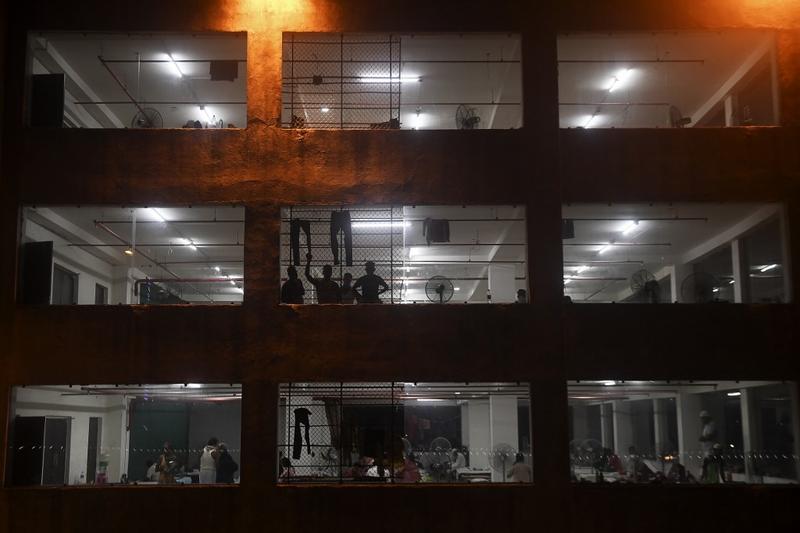Medical supplies from Chinese companies help India in its fight against COVID-19
 (LI MIN / CHINA DAILY)
(LI MIN / CHINA DAILY)
More than 1.3 billion people in India remain confined at home since the imposition of a national lockdown on March 25 to fight the COVID-19 pandemic.
While this is tough for anyone, it is especially so for those living in Asia’s largest slum — Dharavi — in Mumbai, the country’s financial capital. The city’s slums are home to an estimated 65 percent of the population of about 12 million in Mumbai’s inner-city area.
Spread over 2.1 square kilometers, Dharavi is home to more than 700,000 people.
Shahid Jameel, a virologist and CEO of the Wellcome Trust/DBT India Alliance, an independent charity organization based in New Delhi that funds health and biomedical sciences research, said: “We have advised people to keep 6 feet, or 1.8 meters, apart, but how is that possible in urban slums? These are the places to watch. I am really worried.”
As in many other parts of the world, schools and colleges are closed, exams suspended, courts and most offices and factories shut, and nearly all forms of transportation halted.
Only doctors, nurses, healthcare support employees and those working to keep essential services running are allowed out of their homes, but under strict safety protocols.
Sunita Narain, director-general of the Centre for Science and Environment in New Delhi, said there is no rulebook to tell governments what to do, how to shut down economies, and when to reopen them.
“COVID-19 is the most tumultuous, most catastrophic and the most defining epoch of our lifetime. One cannot think of anything else that has happened with such speed — from the end of December, when the first cases were reported in China, to now,” she said.
“This is an extraordinary situation that the entire country is grappling with.”
Debabrata Mitra, a doctor, said: “Such is the scale of the virus’ impact, and the unpredictability of the harm it can do to humans, economies and society, that we do not really know yet what we must do.
“About 70 percent to 80 percent of patients are asymptomatic — which means they are potent carriers of the virus. That is very worrying,” he added.
Another concern is that scores of people with severe diseases, including cancer, are not getting urgent and adequate medical attention in such challenging times.
With the number of infections and deaths mounting, many wards in Indian hospitals — both government and private — have been converted into coronavirus units.
Cases of doctors and nurses becoming infected with the virus are rising daily. “Worse, they face being socially ostracized despite trying their best with limited resources,” Mitra said.
Maharashtra, a state with high-density populations in urban areas, has reported the most cases in India.
“However, now the situation in states such as Madhya Pradesh and Gujarat is also not looking good,” said Jameel, the virologist.
Poverty-stricken slum-dwellers live amid poor sanitation and have low health awareness.
At the best of times, Dharavi is a breeding ground for disease, with clusters of houses lining a maze of narrow alleyways, many of these next to a huge open drain that runs through the area.
 People are seen inside a temporary quarantine centre during a government-imposed nationwide lockdown as a preventive measure against the COVID-19 coronavirus, in Kolkata on April 17, 2020. (DIBYANGSHU SARKAR / AFP)
People are seen inside a temporary quarantine centre during a government-imposed nationwide lockdown as a preventive measure against the COVID-19 coronavirus, in Kolkata on April 17, 2020. (DIBYANGSHU SARKAR / AFP)
This community poses one of the biggest challenges to the Maharashtra government and the municipal authorities in Mumbai as they try to contain the virus.
By May 16, Maharashtra had reported 30,706 confirmed COVID-19 cases and 1,135 deaths from the disease. As of May 15, Dharavi had 1,145 reported cases.
To make matters worse, many people have ignored the lockdown, preferring to venture outdoors, rather than remain in crowded rooms.
A form of paranoia has set in among those stuck at home, as the lockdown threatens the Indian economy and people’s livelihoods. Even so, imposing it was the only logical step.
Archana Majumdar, a senior doctor with the Ministry of Health and Family Welfare’s Central Health Services, said: “It is the only way to put the brakes on the spread of the deadly virus, which has claimed thousands of lives worldwide.
“In view of the high population density, especially in cities, we must all strictly follow lockdown protocols. There are no two ways about it.”
The number of coronavirus infections in India could soar in the next two months if preventive measures, including isolation and social distancing, are not followed strictly, she said, adding that aggressive action is needed to test as many people as possible, as well as to isolate and treat those who become infected.
“Things are getting better as far as awareness is concerned,” but unless the country is united in following safety measures, the situation could still get out of hand, Majumdar said.
She added that there is an urgent need to obtain rapid testing kits. These can be used in hotspots and containment areas, as well as in places that are reportedly free of the virus.
To combat the outbreak, India is continuing to import medical supplies from China.
India’s Ministry of External Affairs said in a statement late last month: “In the past two weeks, around two dozen flights have departed for India from five cities in China, carrying nearly 400 metric tons of medical supplies.”
Ministry spokesman Anurag Srivastava was quoted by Indian media as saying that flights were likely to be stepped up considerably in the next few months as efforts to obtain medical supplies gain momentum.
He said two Chinese companies, Guangzhou Wondfo Biotech, in Guangzhou, Guangdong province, and Zhuhai Livzon Diagnostics in Zhuhai, Guangdong, had supplied a batch of test kits to India, with the former sending 300,000 kits and the latter 250,000.
India had ordered 3.7 million rapid antibody test kits from companies based in China, South Korea and Singapore, Srivastava said.
As testing increases, it appeared likely that the number of infections would continue to rise, even though the lockdown has lowered the transmission rate. India on May 17 extended the lockdown for two more weeks, till May 31. This was the third extension imposed to control the coronavirus pandemic.
Millions of migrant workers and local daily wage earners are among those worst hit by the lockdown.
They have found themselves trapped in a situation where they can neither find work nor return to their villages. Nearly all the stranded migrant workers nationwide have exhausted their meager savings and are now dependent on community kitchens run by government or nongovernmental organizations.
These migrants comprise about 20 percent of the country’s workforce.
Just before the lockdown was enforced, Manas Mondal, 21, lost his job as a guard at an information technology office in Bengaluru, Karnataka, and returned to his village in West Bengal, some 1,900 kilometers away. He said he is scared of going back to Bengaluru, adding, “I will try to do something at home.”
For him and many others, the outbreak came as a shock. However, there is hope and the authorities are continuing to take action.
The government has earmarked some 170 virus hotspots based on testing, occurrence of cases and contacts.
Jameel, of the Wellcome Trust/DBT India Alliance, said: “The other obvious places are large cities, especially urban slums. These have the disadvantages of being close to places where the virus was initially imported, and a high population density, making social distancing impractical.”
Measures that are needed urgently include isolating cases, speeding up contact tracing, quarantine precautions and using rapid antibody tests in areas with high-density populations, Jameel said, adding, “Urban slums must be top priority.”
While the states of West Bengal and Karnataka focus on getting food and medicines to the needy and the elderly, Odisha state is paying special attention to honor those treating coronavirus patients.
With many cases of infection reported among doctors and other healthcare workers, the Odisha government said the “COVID warriors” who die while treating coronavirus patients will be treated “as martyrs”.


